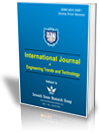Optimization of Fatigue Response in Notched AISI 316L Friction Welded Joints Using a Hybrid Entropy-VIKOR-Taguchi Approach
Optimization of Fatigue Response in Notched AISI 316L Friction Welded Joints Using a Hybrid Entropy-VIKOR-Taguchi Approach |
||
 |
 |
|
| © 2025 by IJETT Journal | ||
| Volume-73 Issue-3 |
||
| Year of Publication : 2025 | ||
| Author : Jagadesh Kumar Jatavallabhula, Vaddi Venkata Satyanarayana, Vasudeva Rao Veeredhi |
||
| DOI : 10.14445/22315381/IJETT-V73I3P120 | ||
How to Cite?
Jagadesh Kumar Jatavallabhula, Vaddi Venkata Satyanarayana, Vasudeva Rao Veeredhi, "Optimization of Fatigue Response in Notched AISI 316L Friction Welded Joints Using a Hybrid Entropy-VIKOR-Taguchi Approach," International Journal of Engineering Trends and Technology, vol. 73, no. 3, pp. 265-273, 2025. Crossref, https://doi.org/10.14445/22315381/IJETT-V73I3P120
Abstract
Current research investigates the effect of notch geometric parameters, viz. width, depth, and central angle, on the fatigue life and stress amplitude of friction-welded AISI 316L stainless steel joints. Despite the extensive use of friction welding, a critical gap exists in understanding how notch geometry influences fatigue performance in engineering applications. The current study addresses this gap by employing a hybrid Entropy-VIKOR-Taguchi technique to optimize fatigue life and minimize stress amplitude. Fatigue specimens were prepared from friction-welded rods according to ASTM E606 standards, with varying notch geometries based on a Taguchi L9 orthogonal array. The un-notched specimen exhibited a fatigue life of 5285 cycles, while notched specimens showed a range from 150 to 1627 cycles. The maximum stress amplitude required to maintain a strain amplitude of 0.3% is 486.70 MPa for the un-notched specimen, whereas, for the notched specimens, it ranges between 332.76 and 540.99 MPa. Optimal parameters were identified as mid-level notch width and depth with a low central angle, leading to a significant improvement in fatigue life and reduced stress amplitude. The ANOVA results show that the notch central angle contributes the most to the overall optimization of the responses, accounting for 31.55%, followed by notch depth at 29.10% and notch width at 20.85%.
Keywords
Fatigue, Notch, VIKOR, Stress amplitude, Strain amplitude, Scanning electron microscope.
References
[1] A. Seshu Kumar et al., “Evaluation of Bond Interface Characteristics of Rotary Friction Welded Carbon Steel to Low Alloy Steel Pipe Joints,” Materials Science and Engineering: A, vol. 824, 2021.
[CrossRef] [Google Scholar] [Publisher Link]
[2] Rajendra Goud et al., Chapter 11-Welding and Joining of Novel Materials, Automation in Welding Industry: Incorporating Artificial Intelligence, Machine Learning and Other Technologies, pp. 183-213, 2024.
[CrossRef] [Google Scholar] [Publisher Link]
[3] Robert Owsinski et al., “Characterisation of Joint Properties through Spatial Mapping of Cracks in Fatigue Specimens, Extracted from the Linearly Friction Welded Steel Coupon,” Precision Engineering, vol. 71, pp. 78-89, 2021.
[CrossRef] [Google Scholar] [Publisher Link]
[4] Yixun Wang et al., “Microstructure, Mechanical Properties and Fatigue Behaviours of Linear Friction Welded Weathering Steels,” International Journal of Fatigue, vol. 159, 2022.
[CrossRef] [Google Scholar] [Publisher Link]
[5] Abbas Mardani et al., “VIKOR Technique: A Systematic Review of the State of the Art Literature on Methodologies and Applications,” Sustainability, vol. 8, no. 1, pp. 1-38, 2016.
[CrossRef] [Google Scholar] [Publisher Link]
[6] Shankar Chakraborty, Prasenjit Chatterjee, and Partha Protim Das, Multi-Criteria Decision-Making Methods in Manufacturing Environments, Apple Academic Press, 2023.
[Google Scholar] [Publisher Link]
[7] Sanni Dev, Amit Aherwar, and Amar Patnaik, “Material Selection for Automotive Piston Component Using Entropy-VIKOR Method,” Silicon, vol. 12, no. 1, pp. 155-169, 2020.
[CrossRef] [Google Scholar] [Publisher Link]
[8] Ashiwani Kumar, Mukesh Kumar, and Piyush Chandra Verma, “Ranking Analysis of AA7075-Cr Alloy Composites Based on Physical, Mechanical, and Sliding Wear Assessment Using Hybrid Entropy-VIKOR Approach,” International Journal of Metal Casting, vol. 18, no. 1, pp. 352-372, 2024.
[CrossRef] [Google Scholar] [Publisher Link]
[9] Ramkumar Yadav et al., “Selection and Ranking of Dental Restorative Composite Materials Using Hybrid Entropy-VIKOR Method: An Application of MCDM Technique,” Journal of the Mechanical Behaviour of Biomedical Materials, vol. 147, 2023.
[CrossRef] [Google Scholar] [Publisher Link]
[10] S. Chandrasekhar, and N.B.V. Prasad, “Multi-Response Optimization of Electrochemical Machining Parameters in The Micro-Drilling of AA6061-Tib2in Situ Composites Using the Entropy-VIKOR Method,” Proceedings of the Institution of Mechanical Engineers, Part B: Journal of Engineering Manufacture, vol. 234, no. 10, pp. 1311-1322, 2020.
[CrossRef] [Google Scholar] [Publisher Link]
[11] Ashiwani Kumar, Mukesh Kumar, and Bhavna Pandey, “Investigations on Mechanical and Sliding Wear Performance of AA7075-SiC/Marble Dust/Graphite Hybrid Alloy Composites Using Hybrid Entropy-VIKOR Method,” Silicon, vol. 14, no. 5, pp. 2051-2065, 2022.
[CrossRef] [Google Scholar] [Publisher Link]
[12] Rajesh Kumar Bhuyan, and Bharat Chandra Routara, “Optimization the Machining Parameters by Using VIKOR and Entropy Weight Method during EDM Process of A-18% Sicp Metal Matrix Composite,” Decision Science Letters, vol. 5, no. 2, pp. 269-282, 2016.
[CrossRef] [Google Scholar] [Publisher Link]
[13] Ali Jahan et al., “A Comprehensive VIKOR Method for Material Selection,” Materials and Design, vol. 32, no. 3, pp. 1215-1221, 2011.
[CrossRef] [Google Scholar] [Publisher Link]
[14] C. Tara Sasanka, and K. Ravindra, “Implementation of VIKOR Method for Selection of Magnesium Alloy to Suit Automotive Applications,” International Journal of Advanced Science and Technology, vol. 83, no. 5, pp. 49-58, 2015.
[CrossRef] [Google Scholar] [Publisher Link]
[15] Xiang Jian-Yang, Song Ren-Ba, and Hou Dong-Po, “Characteristics of Mechanical Properties and Microstructure for 316L Austenitic Stainless Steel,” Journal of Iron and Steel Research International, vol. 18, no. 11, pp. 53-59, 2011.
[Google Scholar] [Publisher Link]
[16] Jay M. Korde, Akhil V. Sreekumar, and Balasubramanian Kandasubramanian, “Corrosion Inhibition of 316L‑Type Stainless Steel Under Marine Environments Using Epoxy/Waste Plastic Soot Coatings,” SN Applied Sciences, vol. 2, no. 7, pp. 1-13, 2020.
[CrossRef] [Google Scholar] [Publisher Link]
[17] Namrata Gangil et al., “Linear Friction Welding of Similar and Dissimilar Materials: A Review,” Metals and Materials International, vol. 31, pp. 1-21, 2024.
[CrossRef] [Google Scholar] [Publisher Link]
[18] Dipen Kumar Rajak et al., “Friction-Based Welding Processes: Friction Welding and Friction Stir Welding,” Journal of Adhesion Science and Technology, vol. 34, no. 24, pp. 2613-2637, 2020.
[CrossRef] [Google Scholar] [Publisher Link]
[19] F.C. Liu, and T.W. Nelson, “Grain Structure Evolution, Grain Boundary Sliding and Material Flow Resistance in Friction Welding of Alloy 718,” Materials Science and Engineering: A, vol. 710, pp. 280-288, 2018.
[CrossRef] [Google Scholar] [Publisher Link]
[20] Douglas C. Montgomery, Design and Analysis of Experiments, 4th ed., John Wiley & Sons, pp. 1-720, 1996.
[Google Scholar] [Publisher Link]
[21] Angela Dean et al., Handbook of Design and Analysis of Experiments, CRC Press, pp. 1-960, 2015.
[Google Scholar] [Publisher Link]

